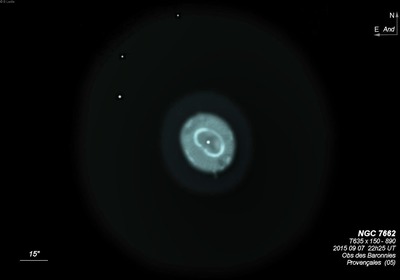Copeland's Blue Snowball
Copeland's Blue Snowball

William Herschel discovered NGC 7662 = H IV-18 = h2241 on 6 Oct 1784 (during sweeps 281-285, which was made in the east) and noted "bright, round, a planetary [with a] pretty well defined disk, 15" diameter with a 7 feet reflector." In his 1811 PT paper, he write "A beautifully bright round nebula, have a pretty well defined disk of about 10 or 12" in diameter. It is a little elliptical, and has a very small star following, which gives us the idea of a small satellite accompanying its planet [from 3 Oct 1790, sweep 964]. It is visible in a common finder as a small star." This may be the first time "planetary" is actually used although earlier, Darquier describes M57 "... as large as Jupiter and resembles a fading planet."
On 1 Oct 1828, John Herschel recorded "A fine planetary nebula. Diameter 12"; with 240 beautifully defined, light, rather mottled, and the edge the least in the world unshaped. It is not nebulous, but looks as if had a double outline, or like a star a little out of focus. A perfect circle." JH measured the 13th magnitude star ~50" NE of center several times (interested in it as a possible satellite of the planetary) and noted "These satellites of planetary nebulae out to be especially attended to."
32 observations were made with Lord Rosse's 72". It was first observed by Rosse and Johnstone Stoney on 31 Oct 1848, "Has a central spot, at moments very dark." Lord Rosse and Stoney made sketches on 16 Dec 1848 revealing the double ring structure and brighter arcs (1850 publication, Fig 13, Plate XXXVIII). Bindon Stoney's sketch on 16 Sep 1852 using a freshly polished speculum shows a prominent central star within a spiral shaped nebula and well-defined "arms".
Using a 9.5" refractor in 1855, Father Secchi described (and sketched) a slightly darker horseshoe-shaped central region and a brighter outer arc, a questionable amount of detail for that aperture. Joseph Winlock and George Searle, observing with the HCO 15-inch refractor around 1866, did not report the central star but "Two edges seen...as of a brighter nebula placed over a dimmer one. The brighter and fainter ellipses have major axes slightly differing in direction; the brighter having the position angle of its major axis 10° to 15° the large"
Barnard thought the central star was variable based on observations with the Yerkes 40-inch in 1897 and wrote a paper in 1908 on "The Variability of the Nucleus of the Planetary Nebula NGC 7662" (MNRAS, 68, 465). The paper includes a superb sketch made with the 40-inch refractor at Yerkes. In 1935, John Duncan wrote "The bright ring of NGC 7662, like that of NGC 6720, has a vivid bluish-green color; but the outer shell, seen with a large reflector [probably with the 60"] on a favorable night, has a pronounced reddish hue."
The nickname "Blue Snowball" is from Leland S. Copeland’s description (1960), "looking like light blue snowball.”
200/250mm - 8" (9/25/81) : slightly darker center at 300-400x, irregular surface brightness.
300/350mm - 13" (9/11/82): darker center, faint outer shell.
400/500mm - 17.5" (10/13/01): at 500x, this blue high surface brightness planetary has a beautiful double-shell structure with a small, dark center. The bright inner structure has a delicate, embedded thinner ring of very high surface brightness, though weaker at the following end. In the center of this ring is a small, darker hole. The fainter, outer envelope is elongated SW-NE, ~35"x25", giving an asymmetric appearance with the outline of the inner ring.
17.5" (10/12/85): extremely bright, very high surface brightness, fairly small, easily takes very high power. At 410x, the planetary appears weakly annular with a slightly darker center. There is a second outer shell, which exhibits subtle structure due to an irregular surface structure, blue-green color is evident. Central star not seen.
900/1200mm - 48" (10/24/14): superb view of the double-shell structure at 610x and 813x. The inner shell is elongated ~3:2 SW-NE, ~18"x12", and contains a remarkable, bright thin rim, so it appears like a racetrack with a dark interior. This delicate but high surface brightness ring is brightest along a 90° arc around the northeast end and nearly as bright in a matching 90° arc on the southwest end. The rim is noticeably weaker on the west and east sides. The elongated darker hole spans a large percentage of the inner shell and is punctuated by a faint, but steadily visible central star.
The outer shell is twice the size (~35"x25"), slightly less elongated, and a bit offset in its major axis (SSW-NNE). The outer rim also has two brighter arcs or strips, but only 25°-30° in length. The more prominent arc is on the southeast side with a weaker strip symmetrically placed on the northwest edge. These strips are 90° offset from the much brighter inner arcs. The outer shell appears irregular in surface brightness with an impression of striations. Surrounding the outer shell there appears to be a very low surface brightness outer halo.
Notes by Steve Gottlieb